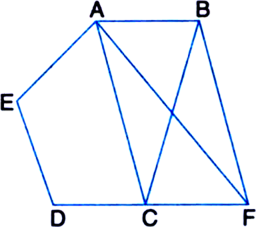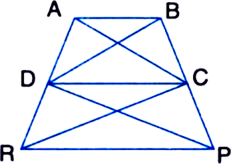 Long Answer Type
Long Answer Type
 Short Answer Type
Short Answer TypeIn figure, ABCDE is a pentagon. A line through B parallel to AC meets DC produced at F. Show that
(i) ar(ΔACB) = ar(ΔACF)
(ii) ar(□AEDF) = ar(ABCDE). 

Given: ar(ΔDRC) = ar(ΔDPC) and ar(ΔBDP) = ar(ΔARC).
To Prove: Both the quadrilaterals ABCD and DCPR are trapeziums.
Proof: ar(ΔDRC) = ar(ΔDPC) ...(1)
| Given
But ΔDRC and ΔDPC are on the same base DC.
∴ ΔDRC and ΔDPC will have equal corresponding altitudes.
∴ ΔDRC and ΔDPC will lie between the same parallels.
∴ DC || RP
∴ □ DCPR is a trapezium.
A quadrilateral is a trapezium if exactly one pair of opposite sides are parallel Again. ar(ΔBDP) = ar(ΔARC)
⇒ ar(ΔBDC) + ar(ΔDPC)
= ar(ΔADC) + ar(ΔDRC)
⇒ ar(ΔBDC) = ar(ΔADC) | Using (1) But ΔBDC and ΔADC are on the same base DC.
∴ ΔBDC and ΔADC will have equal corresponding altitudes.
∴ ΔBDC and ΔADC will lie between the same parallels.
AB || DC
∴ □ABCD is a trapezium.
A quadrilateral is a trapezium if exactly one pair of opposite sides is parallel
Show that the area of a rhombus is half the product of the lengths of its diagonals.
Or
Prove that the area of a rhombus is equal to half the rectangle contained by its diagonals.
